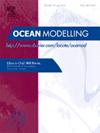用时间融合变压器校正基于物理的全球潮汐和暴雨水位预报
IF 2.9
3区 地球科学
Q2 METEOROLOGY & ATMOSPHERIC SCIENCES
引用次数: 0
摘要
随着算法的改进,更精细的离散化和高性能并行计算,全球和沿海海洋表面水高度预测技术有了很大的进步。模型技能与网格分辨率、指定水深/地形的准确性、耗散参数化、海气阻力公式和强迫函数的保真度有关。风力控制技术尤其容易出错,特别是在陆地-海洋交界面。由此产生的偏差和错误可以通过机器学习(ML)方法全面解决。在此,我们将时间融合变压器与美国国家海洋和大气管理局(NOAA)的风暴和潮汐业务预报系统(STOFS-2D-Global)弱耦合,以提高其在7天范围内的预报能力。我们在NOAA国家海洋局运营的228个观测水位站展示了变压器丰富水动力模型输出的能力。我们得出结论,只要提供足够的协变量,变压器是一种快速校正STOFS-2D-Global预测水位的方法。对于风优势地区的气象站,我们证明了包括过去和未来的风速协变量使预报更加熟练。一般来说,虽然变压器在潮汐和风力优势站都提供一致的修正,但它在潮汐优势站的修正力度最大。我们在阿拉斯加以及美国大西洋和太平洋沿岸地区显示了显著的改善。我们评估了几个使用不同超参数、协变量和训练数据实例化的变压器,以提供如何提高性能的指导。本文章由计算机程序翻译,如有差异,请以英文原文为准。
Correcting physics-based global tide and storm water level forecasts with the temporal fusion transformer
Global and coastal ocean surface water elevation prediction skill has advanced considerably with improved algorithms, more refined discretizations, and high-performance parallel computing. Model skill is tied to mesh resolution, the accuracy of specified bathymetry/topography, dissipation parameterizations, air-sea drag formulations, and the fidelity of forcing functions. Wind forcing skill can be particularly prone to errors, especially at the land-ocean interface. The resulting biases and errors can be addressed holistically with a machine-learning (ML) approach. Herein, we weakly couple the Temporal Fusion Transformer to the National Oceanic and Atmospheric Administration’s (NOAA) Storm and Tide Operational Forecast System (STOFS-2D-Global) to improve its forecasting skill throughout a 7-day horizon. We demonstrate the transformer’s ability to enrich the hydrodynamic model’s output at 228 observed water level stations operated by NOAA’s National Ocean Service. We conclude that the transformer is a rapid way to correct STOFS-2D-Global forecasted water levels provided that sufficient covariates are supplied. For stations in wind-dominant areas, we demonstrate that including past and future wind-speed covariates makes for a more skillful forecast. In general, while the transformer renders consistent corrections at both tidally and wind-dominant stations, it does so most aggressively at tidally-dominant stations. We show notable improvements in Alaska and the Atlantic and Pacific seaboards of the United States. We evaluate several transformers instantiated with different hyperparameters, covariates, and training data to provide guidance on how to enhance performance.
求助全文
通过发布文献求助,成功后即可免费获取论文全文。
去求助
来源期刊

Ocean Modelling
地学-海洋学
CiteScore
5.50
自引率
9.40%
发文量
86
审稿时长
19.6 weeks
期刊介绍:
The main objective of Ocean Modelling is to provide rapid communication between those interested in ocean modelling, whether through direct observation, or through analytical, numerical or laboratory models, and including interactions between physical and biogeochemical or biological phenomena. Because of the intimate links between ocean and atmosphere, involvement of scientists interested in influences of either medium on the other is welcome. The journal has a wide scope and includes ocean-atmosphere interaction in various forms as well as pure ocean results. In addition to primary peer-reviewed papers, the journal provides review papers, preliminary communications, and discussions.
 求助内容:
求助内容: 应助结果提醒方式:
应助结果提醒方式:


